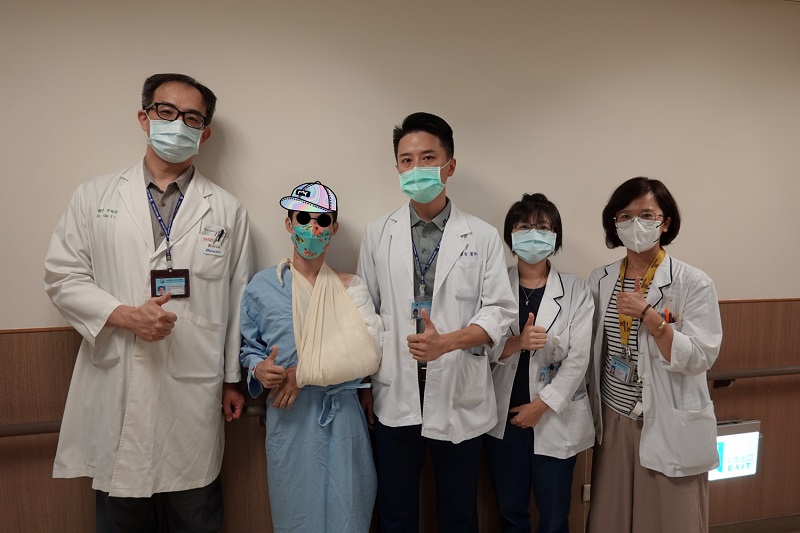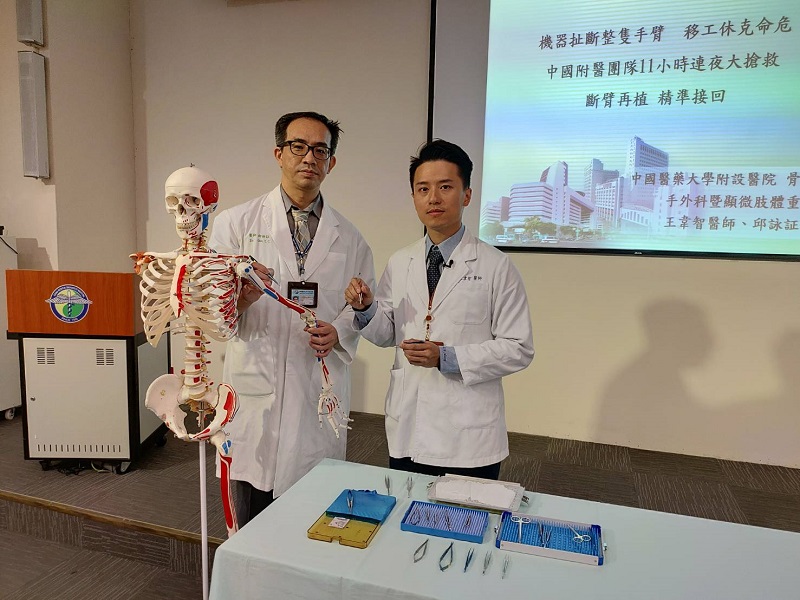News and Award
About CMUH
Whole arm pulled apart by machine
The 22-year-old male immigrant worker, Nann (assumed name), has come to Taiwan for years to earn his living. He lives in Central Taiwan, where he works as a technician in a factory. On July 31st, Nann suffered a serious accident while working on site. His left arm was pulled from his shoulder by the machine so that his arm was torn off with broken bone and muscle; he experienced a severe hemorrhage that caused him to develop shock, and he was on the verge of dying. He was immediately sent to the area hospital for emergency care. Since his broken arm required a medical microscope and instruments for microsurgery to fix, the team needed to seize all the time they had to initiate a surgery to rebuild the nervous system and blood vessels, a finely implemented and very difficult task. Following the area hospital team’s assessment, Nann was transferred to the medical center, where the limb reconstructive microsurgery team of the Department of Orthopedics, China Medical University Hospital, took over the task of performing the “Replantation of Amputated Arm” surgery. The team saved the life of Nann performing an overnight operation for 11 hours that successfully reattached his arm.

Chief of the limb reconstructive microsurgery team under the Department of Orthopedics, CMUH, Dr. Yung-Cheng Chiu said that Nann received 12 days of intensive care in the ICU after the surgery. The attending physician assessed him to be stable, and he was transferred to the orthopedic ward for nearly two months of hospitalization. He received eight reconstructive surgeries during that period, and each step of the procedures was a challenge. Nann has recovered quite well and can even rotate his arm, but the motion of his fingers will continue to be observed for three months.
Dr. Yung-Cheng Chiu pointed out that every second counts when we are saving a broken limb. While receiving the call for the emergent case, the members of the reconstructive microsurgery team were assembled right away and the operation room was prepared; the anesthesia team was simultaneously called so that the patient could be sent for surgery in the shortest time. The broken arm replantation surgery lasted 11 hours, and then the patient was sent to the ICU for close monitoring, including blood flow, wound infection conditions, and potential muscle swelling or necrosis following the surgery.
Chief Yung-Cheng Chiu indicated that the difference between this case and general fracture surgeries is that only the broken bones need to be connected in general fracture cases, while broken arm replantation surgery has to reconstruct the bones of the arm, arteries and veins, nerves, ligaments, and tendons. In particular, the physician needs to use a microscope to accurately identify the function level of each nerve and the health condition of each blood vessel in the contaminated broken arm collected from the machine. In addition to the surgeon’s past successful experiences, the required energy level of the surgeon needs to be even higher than that for other surgeries because it so time consuming. In the surgery, three nerves and four blood vessels (one artery, three veins) were connected, and the humerus fracture was also managed.
Microsurgery is like taking a long drive; your body needs to maintain the same posture for a long time and constantly stare at the front visual field. Not only does this require the surgeon’s focused concentration, but it also very energy consuming. As a result, only some young orthopedists are willing to dedicate their practice to this territory.
Chief Yung-Cheng Chiu further explained that broken arm replantation is very difficult, and some high risks can develop after the surgery. A very capable surgical team is needed as the offense and a strong care team as the defense in order to achieve the goal. Therefore, I’d like to say special thanks to Dr. Wei-Chih Wang, the nurse specialists, Shu-Hun Chen, and Fang-Wei Chou of the team, who thoughtfully cared for the patient day and night to ensure that his wound became stable.
Today, Nann can smile again with hope. Through subsequent aggressive rehabilitation and treatment, he will have a better chance to regain his quality of life.




![[Taiwan–Malaysia Medical Innovation Forum] CMUH and UNIMAS Co-Host Major Medical Symposium to Advance Medical Technology and Precision Patient Care img](/FileUploads/News/20250714_131324.jpg?w=250&h=180&mode=crop&scale=both)